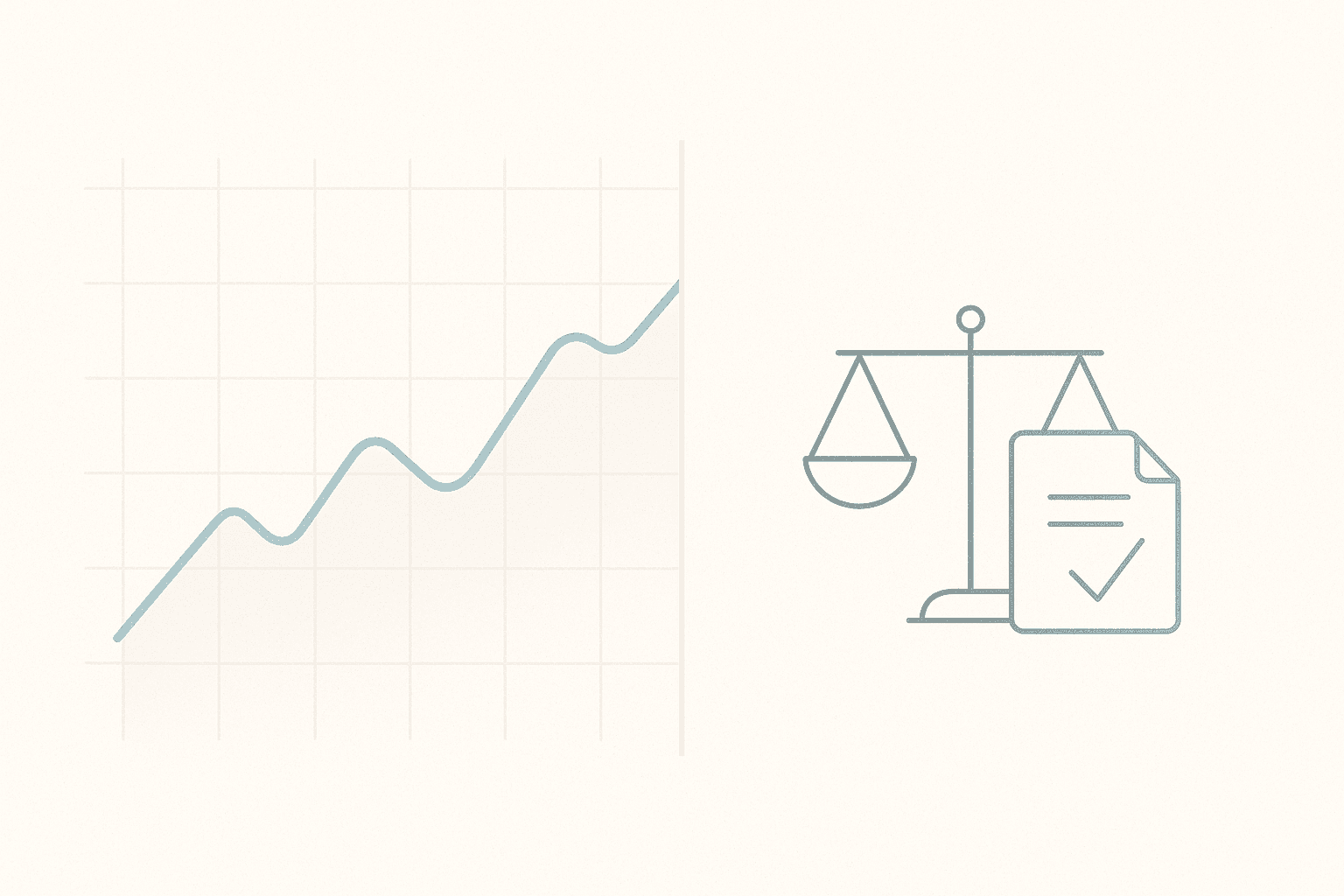AI Lawyer Blog
Bug Bounty Policy Template (Free Download + AI Generator)

Greg Mitchell | Legal consultant at AI Lawyer
3
A Bug Bounty Policy sets the rules for how external security researchers can report vulnerabilities in your products, apps, or infrastructure — and how you will respond and reward them. It defines scope, safe-harbor language, reporting channels, severity ratings, disclosure timelines, and payout guidelines (if paid). The goal is to reduce risk by encouraging responsible disclosure before attackers can exploit flaws.
According to IBM’s 2024 Cost of a Data Breach report, the average global breach cost reached USD 4.88 million, underscoring the value of catching issues early through coordinated disclosure and bounty programs. CISA’s continuously updated Known Exploited Vulnerabilities (KEV) Catalog shows how quickly real-world exploits emerge, reinforcing the need for rapid intake and remediation processes. HackerOne’s 2024–25 report highlights $81M in payouts in one year across thousands of programs, reflecting widespread adoption of hacker-powered security.
Download the free Bug Bounty Policy Template or customize one with our AI Generator, then have a local attorney review before you sign.
You Might Also Like:
Business Continuity Plan Template (Free Download + AI Generator)
Bring Your Own Device (BYOD) Policy Template (Free Download + AI Generator)
1. What Is a Bug Bounty Policy?
A Bug Bounty Policy is the public document that communicates how you want researchers to engage with your systems. It specifies in-scope assets, prohibited testing methods, safe-harbor protections, how to submit reports, severity definitions, service-level targets, and whether you offer monetary bounties or recognition only.
Unlike a private penetration test, a bug bounty program is continuous and community-driven. With the right policy, you channel researcher energy into responsible findings, filter noise through clear triage criteria, and ensure fixes are prioritized based on risk to users and the business.
2. Why a Bug Bounty Policy Matters in 2025?
Security exposure changes daily as new CVEs and supply-chain risks surface. KEV updates from CISA demonstrate how quickly exploitable vulnerabilities appear; programs need well-defined intake and response pathways to keep pace.
Budgets are finite, and prevention is cheaper than recovery. With breach costs averaging multi-million dollars, a well-run bounty or vulnerability disclosure program (VDP) can surface critical issues earlier and for a fraction of post-incident costs.
Finally, customers, regulators, and partners increasingly expect a published policy — especially for SaaS and fintech platforms, to evidence security maturity and encourage coordinated disclosure.
3. Key Clauses and Components
Program Purpose: State the objective to improve security through responsible disclosure and to protect users.
Scope Definition: List domains, apps, APIs, and environments that are in scope; expressly list out-of-scope systems (e.g., third-party providers).
Testing Rules: Permit non-disruptive testing; prohibit DDoS, social engineering of employees, or accessing customer data without consent.
Safe Harbor & Legal Protections: Affirm good-faith research will not trigger legal action under anti-hacking laws when the policy is followed.
Reporting Channel: Provide a single email or platform submission path and a required report format (steps, impact, evidence).
Severity & Reward Model: Map severities to CVSS or your rubric; state bounty ranges or recognition criteria for each severity.
Service Levels: Define initial acknowledgement, triage target, remediation targets, and retest timelines.
Disclosure Policy: Explain when public disclosure is permitted (e.g., after fix or after a fixed timeline) and how credit is granted.
Privacy & Data Handling: Clarify how researcher data is processed (e.g., for payment or tax), retention periods, and privacy rights.
Program Governance: Identify the security owner, escalation path, and how policy updates will be announced.
4. Legal and Regulatory Considerations
Safe Harbor Language: Align with U.S. DOJ CFAA guidance and your jurisdiction’s anti-hacking statutes; clearly state authorized testing boundaries.
Export Controls & Sanctions: Ensure payouts and engagement do not violate sanctions or export-control regimes; maintain a restricted-party screening step.
Privacy Laws: Address GDPR/UK GDPR/CCPA obligations when reports include personal data; define lawful basis and data-minimization steps.
Sector Rules: If you are public or highly regulated, coordinate with legal regarding incident-disclosure and reporting obligations (e.g., SEC material incident disclosures for U.S. public companies).
Tax & Payment Compliance: Document KYC/withholding requirements for international rewards; include alternatives (charity, swag) where cash is restricted.
5. How to Customize Your Bug Bounty Policy?
Risk-Based Scope: Start with internet-facing assets that hold sensitive data; expand in phases as triage capacity grows.
Reward Strategy: Calibrate bounties to potential impact and your risk appetite; consider higher rewards for RCE, auth bypass, and data-exfiltration flaws.
VDP vs. Bounty: If payouts aren’t feasible, start with a VDP that recognizes researchers, then graduate to paid bounties later.
Brand & Community: Decide whether to maintain a public Hall of Fame and how you will attribute researchers in release notes.
AI and Third-Party: If you host LLM features or rely heavily on vendors, include specific do’s and don’ts (e.g., no prompt-spam against other tenants) and define responsibilities for third-party bugs.
6. Step-by-Step Guide to Launching One
Step 1-Define goals: Decide what success looks like — reduction in critical vulns, faster MTTR, coverage of high-risk assets.
Step 2-Map scope: Inventory domains, apps, APIs, and integrations; mark in-scope vs. out-of-scope with clear boundaries.
Step 3-Design rules: Write testing rules, safe-harbor language, and a concise reporting template with required evidence.
Step 4-Set rewards: Create severity tiers tied to CVSS or your rubric; publish bounty or recognition ranges and duplications policy.
Step 5-Build triage: Stand up an intake queue, assign on-call rotations, and define SLAs for acknowledgement, triage, fixes, and retests.
Step 6-Pilot privately: Invite a small researcher cohort to test rules, SLAs, and payout flow; adjust based on signal-to-noise.
Step 7-Publish policy: Post your policy page, scope, and contact; announce the program and how to participate.
Step 8-Measure & iterate: Track time-to-acknowledge, time-to-fix, severity distribution, and payout ROI; tune scope and rewards accordingly.
7. Tips for Researcher Relations and Triage
Respond quickly: Fast acknowledgements earn goodwill and reduce duplicate submissions.
Be specific: Provide reproduction steps you tried; request exact evidence needed for impact assessment.
Reward fairly: Pay promptly and consistently within advertised tiers; explain decisions transparently.
Close the loop: After fix, share a brief root-cause note (sanitized) and thank the researcher publicly if they agree.
Plan surge capacity: When KEV adds a hot CVE, expect bursts of reports; pre-stage response scripts and patch playbooks.
8. Checklist Before You Publish
Scope page lists in-scope assets and explicit out-of-scope items.
Safe-harbor language clearly protects good-faith research within rules.
Single reporting channel documented with required report format.
Severity rubric and reward/recognition tiers defined and public.
SLAs for acknowledgement, triage, fix, and retest are measured and realistic.
Privacy, sanctions, and tax disclosures prepared for international payouts.
Internal on-call, escalation, and patch workflows ready.
Legal and communications teams briefed on disclosure timelines.
Download the Full Checklist Here
9. Common Mistakes to Avoid
Vague scope that invites testing of third-party systems you don’t control.
No safe-harbor, creating legal risk for good-faith researchers and your brand.
Unclear payout logic that leads to disputes and public criticism.
Ignoring disclosure timelines, leaving researchers in limbo or prompting premature drops.
Under-resourced triage so reports languish and duplicates overwhelm the queue.
10. FAQs
Q: Do we need a paid bounty, or is a VDP enough to start?
A: Many organizations successfully begin with a VDP that invites responsible disclosure without monetary rewards, then transition to paid bounties once workflows stabilize. A VDP still requires clear scope, safe-harbor, and SLAs. Paid programs generally attract more talent and deeper testing, but only if triage capacity and payout consistency are in place.
Q: How should we set bounty amounts fairly?
A: Tie rewards to impact, not effort. Map to CVSS or a custom rubric that reflects business risk, for example, remote code execution and authentication bypass at the top, minor info disclosure at the bottom. Benchmark against industry peers and adjust to encourage quality reports. Publish ranges so expectations are clear and defensible.
Q: What safe-harbor wording do researchers expect?
A: Researchers look for language affirming that authorized, good-faith testing within scope will not lead to legal action under anti-hacking laws, and that accidental exposure of data (immediately reported and not retained) won’t trigger punitive responses. Include guidance on prohibited techniques and a commitment to handle reports professionally.
Q: How do we prevent duplicates and low-quality submissions?
A: Keep scope specific and publish examples of in-scope vs. out-of-scope issues. Require proof-of-concept steps and impact explanation in the report template. Rate-limit submissions if abuse occurs and maintain a searchable list of previously resolved reports or “known issues” to reduce noise.
Q: What metrics prove the program’s value?
A: Track time-to-acknowledge and time-to-fix by severity, number of criticals found pre- vs. post-launch, payout-to-risk avoided ratio, and percentage of duplicate/invalid reports. Compare trends during major CVE events (e.g., new KEV additions) to validate readiness and responsiveness. Use these metrics to refine scope, rewards, and staffing.
Sources and References
Security and breach-cost statistics in this article draw from the IBM Cost of a Data Breach Report 2024 and the Cybersecurity and Infrastructure Security Agency (CISA) Known Exploited Vulnerabilities (KEV) Catalog, which track active exploitation trends and remediation urgency.
Industry reward and participation metrics reference the HackerOne 2024–2025 Hacker-Powered Security Report summarizing payout volumes and program adoption rates across global sectors.
Legal and safe-harbor frameworks align with U.S. Department of Justice Framework for a Vulnerability Disclosure Program for Online Systems and related CFAA good-faith research guidance.
Disclaimer
This article is for informational purposes only and does not constitute legal advice. Laws and regulations vary by jurisdiction and change over time. Always consult qualified legal counsel and security leaders before publishing or relying on a Bug Bounty Policy.
Get Started Today!
A clear Bug Bounty Policy builds trust with researchers, accelerates fixes, and reduces breach risk. Use it to define scope, protect good-faith testing, and standardize remediation.
Download the free Bug Bounty Policy Template or customize one with our AI Generator, then have a local attorney review before you sign.
You Might Also Like:



